Words on Wellness. Seagrass Meadows
Winter seas can be windy and rough and so it’s a perfect time to enjoy the more subdued habitat of rivers and estuaries along the coast. In these shallows you may notice seagrasses, one of the only flowering plants that can grow in marine waters. Eelgrass (Zostera spp.) is the most common, though surfgrass (Phyllospadix spp.) can also be found. Seagrass communities support a diversity of life and can form extensive beds in shallow, protected, nearshore environments. Although they often receive little attention, meadows of seagrass are some of the most productive ecosystems in the world.
Such meadows are home to a diversity of species like oysters, clams, Dungeness crab and twelve species of fish along the west coast that are residents or rely for part of their lifecycle in this habitat. All species of salmon, trout and bat rays prefer eel grass communities on a seasonal basis as nurseries and refuge from predation. Walking along river banks or paddling your kayak you will see ducks and geese directly forage on the grasses and shorebirds dip in to snack on invertebrate life.
Eelgrass meadows are integral to our own health because they improve water quality locally and regionally by trapping and storing particulates. Bacteria associated with eelgrass inhibits the growth of harmful algal blooms and the grasses also stabilize river banks in times of flood. Traditional ways of life all over the world have long been associated with seagrass meadows. On the West Coast, indigenous peoples used eelgrass twisting sticks to harvest the plants, which they then dipped in fish oil to eat. Roots of seagrasses were also eaten and used by some tribes to create a tonic for uterine or stomach problems.
Seagrass takes up carbon dioxide in the water by photosynthesis, then incorporates that carbon into its tissues. This sequestering of carbon, like the forest, slows global warming while providing oxygen. Because it depends on inshore areas, this precious habitat has been drastically reduced by development, chemical run off and vessel activity. Ecologist are working to restore these habitats, now more necessary in our rapidly changing climate conditions. We can all do our part to help by discontinuing the use of chemical detergents, pesticides, herbicides, preventing erosion of topsoil and reducing plastic waste wherever we live. Take time to quietly enjoy this amazing ecosystem.






